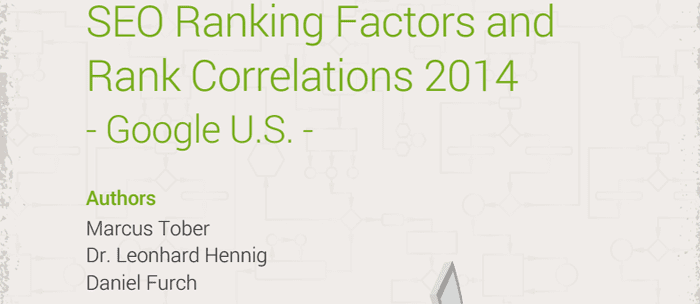Every year, SearchMetrics compiles a correlation study that analyzes which search ranking factors are most impacting the SERPs from an organic perspective (i.e. SEO). Since the 2014 edition was just released, now is a great time to dig in and analyze the findings.
Quick caveat – the SearchMetrics report analyzed correlation, i.e. what assumed SEO factors were correlated with higher rankings based on the data set they reviewed. As any good scientist should understand, correlation does not always imply causation. When looking at the numbers, be careful not to take too large of a leap of faith and start drawing seemingly concrete conclusions. There could be other factors at play that are leading to the correlations. Regardless, it is important to understand the traits that the leaders exhibit if you aim to become one of them in the future.
Rather than go extra deep on the research, I’ll spend my time on the highlights and key findings. Some of the data merely illustrated trends we already know are under way, while others made me take pause.
2014 Search Ranking Factors: The Key Points
Let’s break the findings down by area of SEO.
Off Page Still Drives the Boat, But Quality is Key
Given the history of manual link penalties and negative algorithmic impact under the various Google Penguin updates, it’s not surprising to see a correlation between high quality links and high rankings. Quantity still matters overall, but it is less of a factor than what domains are linking to your website.
Although the off page factors were within a margin of error, it was interesting to me to find that volume of nofollow backlinks is now well correlated with higher rankings. This aligns with the findings that Rand Fishkin and the IMEC Labs team of experimenters uncovered earlier in the year. I’d wager that there are two sub-factors at play here. First, nofollow links may not pass pagerank, but they still count as “votes” for the content. And second, nofollow links are a signal of a healthy, more natural link profile as well as engagement by the social communities. These are all things that Google has gone on record saying they use to identify who plays by the rules.
As you might expect, anchor text keywords are playing a smaller role in driving top of page 1 rankings than they have in the past. The leaders on the SERPs tend to have higher word count in the anchor text and a variety of verbiage used. If you are building links, be sure to vary it up widely and include more words in the anchors to align with this correlation.
Technical SEO Factors Still Play A Heavy Role
The study found that several key structural and technical components factored heavily into which sites ranked better than others. The big three we took note of were:
- Strong Information Architecture
- Internal Linking Structures
- Page Load Time / Performance
There has been a lot of discussion about how page load time impacts overall SEO performance, and this suggests that those discussions are right on point.
Other areas that came to light were based on how the site is laid out / structured and interlinked. Sites with poor internal linking were found to perform worse than better managed internal linking approaches. Information architecture, i.e. the navigation and overall structure of the “levels” and sections of a website, is also a critical search ranking factor to get right. A clear hierarchy with clustered topics across the site is key to informing the search engines what your site is about and where to route visitors when they arrive at your website.
On Page Optimization Matters, But Is Less Important Than Before
The study clearly indicated that keyword stuffing is passe, so it is more important than ever to avoid over optimizing your content for exact match keywords. Keyword density is no longer important, although it’s natural for variations on your keyword to appear frequently within the content itself. Keep everything written in natural language and use the terminology that relates to your topic area, and you can forget about worrying over how many times you mentioned a keyword. It’s impractical at this point.
Keep managing page titles, meta descriptions, image alt-tags, and the typical candidates for on page. Also be sure to include the keywords in H1 and H2 tags, as those look to have a pretty decent impact. EMDs and PMDs are history now, and it’s no longer critical to cram the keywords into the URL (although it does help the page look natural, just no impact on ranking based on this study). Otherwise, just write the body copy naturally and move on.
Social Media Is Impacting SERPs Less
After seeing social media take a noticeable leap in correlation to rankings during the 2013 search ranking factors study, social appears to have given back some of those gains. Given the increased correlation to nofollow links, it is possible that the impact of social has shifted from Likes and +1s to overall shares. Especially in light of the sunsetting of several features by Google and apparent decrease in focus on Google+, this makes sense.
So keep doing social for the other great reasons you do it, but just know that it may not be helping your SEO as much as you were hoping it would one day.
Topic-Driven Content Marketing and Semantic Keyword Targeting Are Paramount
The data shows clearly that “relevant, holistic content ranks better over the long-term.” What does this mean?
It’s all about content, topics, and semantics. Keywords in the content matter, as do co-occurrence of related terms. For example, Google and Penalty, or Penguin and Algorithm would often co-occur in a piece about off page penalties and updates.
The bottom line is that better rankings are being awarded to content that uses a rich mix of verbiage around a topic. Mix in co-occurring words, synonyms, related terminology, and topic-specific jargon at will. It will only strengthen your positioning for ranking on semantic variations and topic areas in Google’s eyes.
There were several other areas they called out under the content and topic area. We have all seen the discussion about In-Depth News at this point, and longer form content does better than pithy blog posts. Rich media also helps for pushing up rankings and helping Google identify relevant topics for ranking content, most likely because image and video rich content is more engaging and shareable.
Materials that are easier to read do better than content that is very advanced. If you have ever used the Flesch Reading Test to benchmark your content, you are one step ahead of the game. If you have not, start using it.
Finally, content with less advertising and distraction on the page seems to do better in the SERPs. This is not a surprise given the page layout updates of the past two years that discouraged the appearance of too many ads above the fold.
Summary
This is the third straight year we’ve analyzed the results of the SearchMetrics research, and we’ve certainly seen some evolution of the search ranking factors over that time. Of course, this is inconclusive but well worth reviewing and understanding. Feel free to download the full PDF if you like, and you can read more of the deep analysis and see the data behind all of these conclusions. Thanks for reading.
Tommy Landry
Latest posts by Tommy Landry (see all)
- Local SEO Meets AEO and GEO: How AI Platforms Read Local Authority Signals - December 9, 2025
- What Is an SEO Proposal and What Should It Include? - December 2, 2025
- The Complete Guide to Dental SEO: How Dentists Can Attract More Local Patients Online - November 25, 2025





